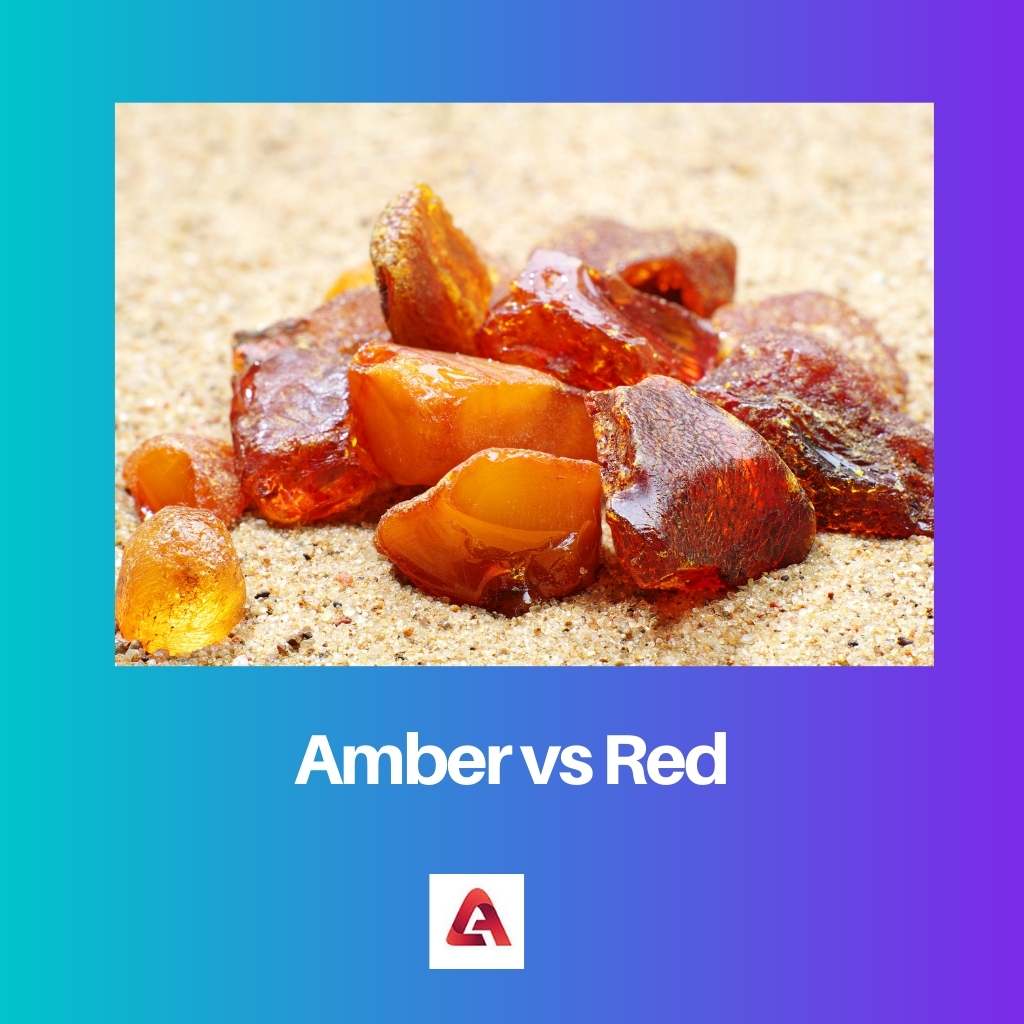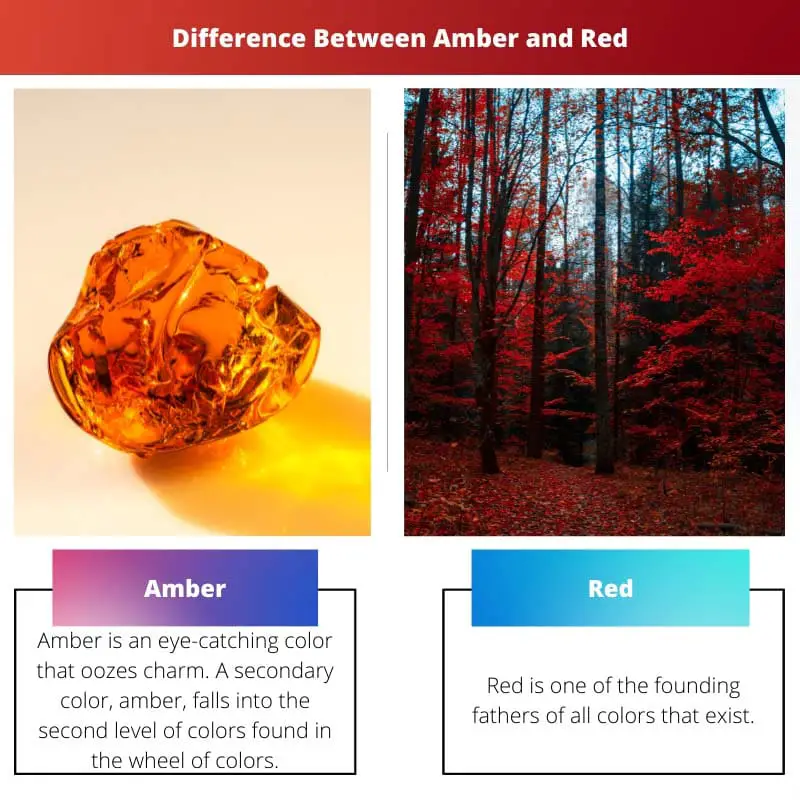Dig out the paintbrushes and wash the old, crusted pain off! Or try to understand the subtle differences between the colors amber and red.
Art jargon is mostly understood by the girl with the paint-streaked hair in the corner, not meant for mortals. However, with a bit of eye squinting and the basic knowledge of colors later, you could also find the difference between the two.
Key Takeaways
- Amber is a warm, yellow-orange hue, while red is a bold, primary color.
- Amber is associated with caution or warning signals, while red signifies danger or stop.
- Amber gemstones are fossilized tree resin, while red gemstones include rubies and garnets.
Amber vs Red
Amber is a warm, yellowish-orange hue reminiscent of the color of the fossilized tree resin amber. It is associated with caution or warning. Red is a primary color that is bright and vibrant, associated with strong emotions such as passion, love, anger, etc.

Amber is a beautiful term. And a spell-binding color. The artist’s palette is balanced at the knife edge between yellow and orange. A color wheel is referred to a circle of color with varying hues.
The color present on it can be categorized into primary, secondary, and complementary colors. Amber falls into the second category.
One of the three primary colors, red, holds a foundational place in the color palette. Red, and its companions, blue and yellow, make up the primary colors that offer roots to every other color formation present.
This makes it impossible to recreate by the mixing of any other colors. Often associated with blood, red is a striking color that gets the attention it demands.
Comparison Table
| Parameters of Comparison | Amber | Red |
|---|---|---|
| Color wheel | Secondary color | Primary color |
| Origin | Consists of yellow and red, in the ratio 3:1. | Base color, cannot be formed by mixing other colors. |
| Frequency | Has a higher wave frequency, by comparison. | Red consists of the lowest frequency of wavelengths present. |
| Iris | Typically contains a golden and rusty hue, owing to the yellow pigment degradation. | Red eyes are a result of albinism. |
| Symbolism | A sign of vitality, strength, and radiance. | Love, passion, rage, anger. |
What is Amber?
Amber is an eye-catching color that oozes charm. A secondary color, amber, falls into the second level of colors found in the wheel of colors.
Amber is based on the colors yellow and red. It is seen to carry undertones of an orange shade in its essence.
The color of the setting sun and the warning light in traffic signals, amber is found in different shades. It yields versatility, which makes it popular.
However, amber is mistaken for orange, yellow, red, or brown. It falls right between the colors yellow and orange. Amber is also a chroma color.
Found to carry a higher number of wavelength frequencies than its origin colors, red and yellow, amber has a less bright presence.
It is composed of seventy-five percent yellow and the remaining twenty-five percent devoted to red.
Amber eyes are uncommon and denote eye colors with a golden and rusty hue. This is due to the degradation of the yellow pigment in the iris, a phenomenon known as lipochrome.
Apart from the rich resin color with a vintage aesthetic feel, amber is also popularly used in symbolic terms.
With its pleasant outlook, amber denotes energy, vitality, and confidence.

What is Red?
Red is one of the founding fathers of all colors that exist. Located at the very heart of the color wheel, it is joined by yellow and blue to make up the primary colors.
It forms the base for several key colors. Red is a bold and striking color that catches one’s eye every time.
Since red falls under the primary color base, no other colors can be mixed or combined to form this color. The color for the red pigment is made from ochre. This is studied as one of the first colors used in prehistoric art.
The human eye captures colors by the frequency of its wavelengths. Seen to be located at one end of the rainbow, red contains the least wavelengths found in all colors.
This makes it easy for us to spot the color. It is infrared light, as it has the lowest wavelengths. 700nm is the wavelength of the color red. Red is
The color red is highly symbolic. Apart from its glaring use as a reminder of the blood, traffic signs, and stop signals, it holds several cultural and social meanings.
Red is popularly known as the color of anger, rage, wrath, fire, and danger. While known for its negative emotions, red is also the color of passion, sensuality, love, love, desire, and longing.
Red is not common eye color. It is only found to exist in cases of severe albinism.

Main Differences Between Amber and Red
- Amber is a secondary color found between orange and yellow. Red is a primary color. The color wheel contains three levels, primary, secondary, and complimentary, each using the former level. It is shown in the form of concentric circles.
- Amber can be created by mixing red, yellow, orange, or brown shades. The combination of any other colors cannot recreate the color red.
- Amber has a comparatively higher wavelength frequency, whereas red has the least ratio of wavelength frequencies in existence.
- While amber symbolizes radiance and safety, its counterpart, red, denotes passion or anger.
- Amber is used on the warning light in the traffic lights. Red is used as the stop sign.

- https://iopscience.iop.org/article/10.1143/JJAP.38.3976/meta
- https://www.bcin.ca/bcin/detail.app?id=64260

Amber is mistaken for orange, yellow, red, or brown. It falls right between the colors yellow and orange. Amber is also a chroma color. Found to carry a higher number of wavelength frequencies than its origin colors, red and yellow, amber has a less bright presence. It is composed of seventy-five percent yellow and the remaining twenty-five percent devoted to red.
Art jargon is mostly understood by the girl with the paint-streaked hair in the corner, not meant for mortals. However, with a bit of eye squinting and the basic knowledge of colors later, you could also find the difference between the two. This makes it impossible to recreate by the mixing of any other colors. Often associated with blood, red is a striking color that gets the attention it demands. Amber is associated with caution or warning signals, while red signifies danger or stop.
Amber vs Red – Amber is a warm, yellowish-orange hue reminiscent of the color of the fossilized tree resin amber. It is associated with caution or warning. Red is a primary color that is bright and vibrant, associated with strong emotions such as passion, love, anger, etc.
So having a painting be mostly red means a much different thing than it being mostly amber.
Interesting to note the important emotional impact of red.
Amber is a beautiful term. And a spell-binding color. The artist’s palette is balanced at the knife edge between yellow and orange. A color wheel is referred to a circle of color with varying hues. The color present on it can be categorized into primary, secondary, and complementary colors. Amber falls into the second category.
Interesting, it’s important to understand the symbolism of colors to make the most of them in art.
The choice of color can truly have an impact on the emotional response a viewer may have to a piece.
Located at the very heart of the color wheel, it is joined by yellow and blue to make up the primary colors. It forms the base for several key colors. Red is a bold and striking color that catches one’s eye every time. Since red falls under the primary color base, no other colors can be mixed or combined to form this color. The color for the red pigment is made from ochre. This is studied as one of the first colors used in prehistoric art.
Interesting to note the use of red as the base for many colors.
I didn’t realize the important historical relevance of the color red.
Amber is a secondary color, amber, falls into the second level of colors found in the wheel of colors. Amber is based on the colors yellow and red. It is seen to carry undertones of an orange shade in its essence. The color of the setting sun and the warning light in traffic signals, amber is found in different shades. It yields versatility, which makes it popular. Amber is an eye-catching color that oozes charm.